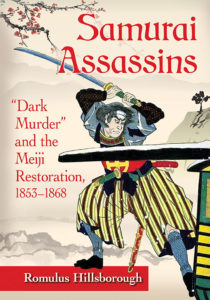
The Japanese word for assassination is ansatsu, “dark murder,” and its significance in the samurai-led revolution which was the “dawn of modern Japan”–when the shogun’s military government was abolished and Imperial rule restored–forms the substance of Samurai Assassins.
The shogun’s government was known as the Bakufu. The samurai revolution that toppled the Bakufu in 1868 is defined by two events. The first was a tumultuous period of bloody conflict between the Bakufu and so-called Imperial Loyalists representing a few of the most powerful samurai clans, which spanned the final fifteen years of the Bakufu. The second was the return of political power from the shogun to the Emperor. These events are collectively referred to as the Meiji Restoration.
For all the impact of “dark murder” on the Meiji Restoration, most of the assassinations covered in Samurai Assassins have thus far received only cursory, if any, attention by Western writers, though the assassins and their deeds are an indelible part of the popular Japanese literary genre that focuses on the final years of the Bakufu. Samurai Assassins is the only thorough presentation and analysis in English of “dark murder” and the assassins who committed it, without which the Meiji Restoration as we know it could not have happened. On a deeper level, the book is a study of the ideology behind the revolution.
My previous book Samurai Revolution: The Dawn of Modern Japan Seen Through the Eyes of the Shogun’s Last Samurai (Tuttle 2014) is a history of the Meiji Restoration and the first ten years of Imperial rule, told from the perspective of Katsu Kaishū, visionary, modernizer and one of the most important men of the era. Samurai Assassins, meanwhile, provides an in-depth overview of the era while focusing on significant men and events, and ideology, not expatiated in Samurai Revolution. The result of thirty years of research and writing, these two books combine to present a comprehensive history of the Meiji Restoration.
Samurai Assassins will make absorbing if sometimes gruesome reading for anybody who wishes to understand the chaos in which the shogunate was finally engulfed, not least for its study of significant figures on various sides of the struggle, such as the reforming Sakamoto Ryoma . . . and his former friend Takechi Hanpeita. . . . The characters of these men come through as clearly as they possibly could, given the documentary limitations under which Hillsborough labours. — The Times Literary Supplement
Samurai Assassins is a well-researched work by a scholar who spent many years in Japan. . . . [It] is an engaging and useful work for anyone interested in the chaos and complexity of the final years of the Tokugawa shogunate. – – John E. Van Sant, University of Alabama-Birmingham. Published on H-Japan, December, 2017
